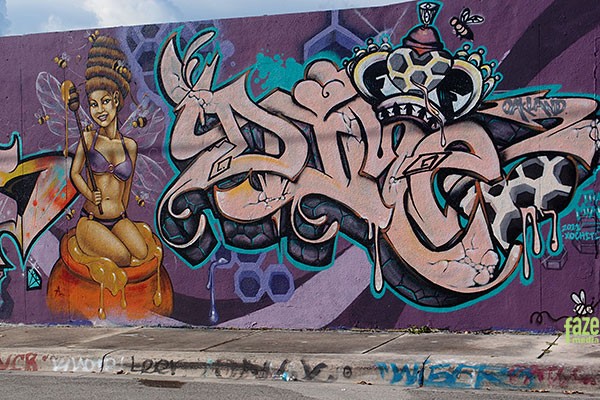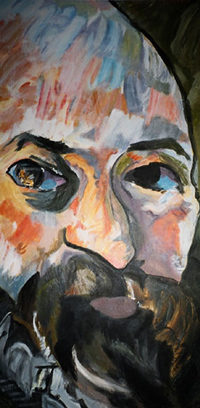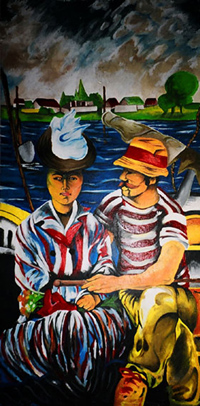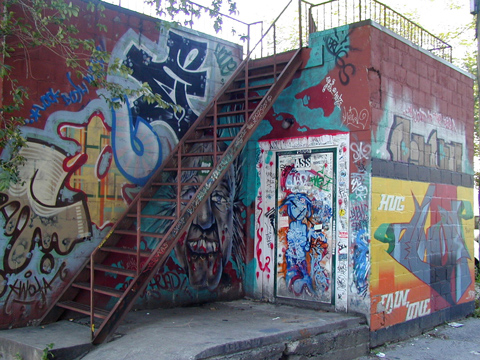
Photo by Z, Miami 2012
 For Josh Goff, graffiti is an addiction. The Regina artist began when he was 17, etching small figures called tags on mailboxes, garbage cans and phone booths. He progressed to larger pieces with more colours in alleys behind buildings and on the sides of train cars. A run-in with police set him straight and turned him “legit.” Now, at 21, Josh is still doing graffiti, but as artwork, with permission and for a profit. “It is addicting,” Josh says. “It’s just a rush that no other drug can compare to. It’s really neat.”
For Josh Goff, graffiti is an addiction. The Regina artist began when he was 17, etching small figures called tags on mailboxes, garbage cans and phone booths. He progressed to larger pieces with more colours in alleys behind buildings and on the sides of train cars. A run-in with police set him straight and turned him “legit.” Now, at 21, Josh is still doing graffiti, but as artwork, with permission and for a profit. “It is addicting,” Josh says. “It’s just a rush that no other drug can compare to. It’s really neat.”
Josh’s favorite piece is found on the back wall of a women’s clothing shop in a trendy area of Regina.  On a bright blue background, the sharp and colourful yellow writing virtually jumps off the bricks. But this lettering can’t be read and has no meaning.
On a bright blue background, the sharp and colourful yellow writing virtually jumps off the bricks. But this lettering can’t be read and has no meaning.
Even Josh admits that “it’s just graffiti,” and says, “It’s always going to have that root in vandalism, but we are trying to take it to another degree.” Graffiti is a word that invokes all sorts of images, from the elaborate murals painted under bridges to the hateful swastikas and racial slurs that have been grabbing headlines.
Is graffiti art or vandalism? The answer depends on who you are and what you do. “It will always be both,” Josh says. “It’s not black or white. You have to think about a lot of elements.”
For Staff Sgt. Heinz Kuck, the issue is not as grey as Josh suggests. Kuck is head of the graffiti eradication program for Toronto police and says, “Whenever graffiti is used as a form of expression on a surface without permission, that is a criminal offence.” According to Kuck, graffiti can lead to what’s called “collateral crime”, adding that 80 per cent of the people Toronto police arrest for graffiti admit to stealing their supplies. He also says that drugs or alcohol are involved in between 60 and 70 per cent of the cases. Then there is the fact that some of the markings can promote hate, and can also be a sign of gang activity.
 Darrell Lechman is trying to bridge the gap between graffiti as art and graffiti as vandalism. Lechman administers an intensive program in Saskatoon called the Urban Canvas, where youth who have a knack for tagging are taught how to turn their illegal chicken scratches into urban art that can end up earning them respect. The program was started several years ago and takes 8 1⁄2 months, full-time, to complete. “It’s sort of like a fast, intensive, shortened fine-arts course from university,” says Lechman. He adds that of the 34 young people who have completed it, he can only think of fewer than six who are now either not in school or working. “We can show them that they can be recognized in a positive sense, not only by their peers — which they are, right now, by doing the graffiti illegally — but be recognized by the better part of society through some positive art shows.”
Darrell Lechman is trying to bridge the gap between graffiti as art and graffiti as vandalism. Lechman administers an intensive program in Saskatoon called the Urban Canvas, where youth who have a knack for tagging are taught how to turn their illegal chicken scratches into urban art that can end up earning them respect. The program was started several years ago and takes 8 1⁄2 months, full-time, to complete. “It’s sort of like a fast, intensive, shortened fine-arts course from university,” says Lechman. He adds that of the 34 young people who have completed it, he can only think of fewer than six who are now either not in school or working. “We can show them that they can be recognized in a positive sense, not only by their peers — which they are, right now, by doing the graffiti illegally — but be recognized by the better part of society through some positive art shows.”
Scott Tobin has made that jump. In Halifax, Tobin is considered an “urban artist” rather than a vandal. At 34, Tobin has been doing graffiti since he was a teenager. In that time, he’s seen his craft transform from an underground taboo to a legitimate art form, sought out by city officials and business owners as a way to liven up the streets. It’s now his full-time job. “It’s been a natural evolution,” Tobin says. “It’s a good living. It keeps getting bigger and bigger.”
Just the facts
ORIGINS: While graffiti can be traced back to ancient civilizations, its North American roots originated from a tradition of subway graffiti in 1970s New York. Hip-hop artists, unable to gain access to mainstream radio, advertised themselves and their music through graffiti.
STREET LINGO: A “tag” is a small marking, usually in only one colour, done by a “tagger.” A “throw up” or a “bombing” is a larger painting, usually involving more than one colour, done by a “bomber.”
FINDING IT: Tags can be found almost anywhere, while throw ups are usually found in lower-traffic areas such as alleys, tunnels or roof tops. Rail cars are popular among elite bombers.
REMOVING IT: On painted surfaces, it is usually painted over at a relatively low cost. On brick, soda blasters or sand blasters are usually needed. Blue and red are the hardest colours to remove.
WHAT IT COSTS: Police quote studies that suggest graffiti costs Canadian taxpayers $1.4 billion annually.
THE LAW: Most graffiti offences are covered under a section of the Criminal Code dealing with the willful destruction of property.
YOU MAY NOT HAVE KNOWN: Graffiti is plural, referring to more than one marking. A graffito is a single mark.
8 Types of Graffiti
Toronto police divide graffiti into eight groups:
Hip-hop: Anything from small tag markings to larger, multicoloured, bubble-letter paintings or murals. By far the largest category, it makes up about 80 per cent of the graffiti in the Toronto area.
Hate crime: Any marking that is an expression of hate toward another person, such as a swastika or a racial slur.
Gang: Similar to hip-hop markings but specific to a street gang or an organized crime group. Can be used to mark territory or recruit members.
Political activism: Markings that make a political statement
Folk epigraphy: Personal messages such as “I love Joe” or “Grad 2003.”
Latrinalia: Restroom graffiti.
Stencilling: Graffiti made by painting over a cut-out.
Cult: Markings made to promote a certain form of worship or cult.
Check out two entire city neighbourhoods celebrating the art of graffiti, also known as muralism in Miami and Houston.


Comments are closed.